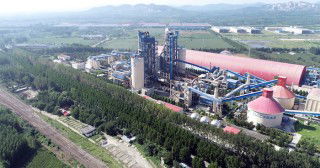What if your machinery could tell you when it needs attention? The latest-generation rotor weighfeeders Pfister® DRW do just that. To ensure optimum runtime of the weighfeeders as well as perfect dosing, FLSmidth Pfister has developed several mechanisms to predict wear effects and decrease them where wear is unavoidable. By FLSmidth Pfister, Germany.
And that strategy is getting even smarter now. FLSmidth Pfister Head of Research & Development, Dr-Ing Daniel Kasperek, recently announced the introduction of a completely new monitoring tool: the Pfister® Wear Index. A state-of-the-art surveillance model of wear will provide customers with the data they need to tailor their maintenance schedules to actual requirements and to order spare parts just in time. All newly-installed rotor weighfeeders Pfister® DRW come with the new feature at no additional cost. Systems already in use can be upgraded for the integration of the new service. “We want to enable our customers to shift from time-driven to necessity-driven maintenance. In other words: predictive instead of preventive maintenance,” Dr-Ing Kasperek points out.
In the future, knowledge about the actual status of the machinery, not a once-set maintenance plan based on estimated data, triggers maintenance performance. Stocking of spare parts over years becomes a thing of the past by using the Pfister® Wear Index. “This reduces the networking capital of our customers. This can be a real benefit in times of tough budgets like now,” Dr-Ing Kasparek explains. Also, unplanned but sometimes unavoidable kiln stops could be used for concurrent maintenance of rotor weighfeeders Pfister® DRW as data referring to their actual condition is on hand. The result: better process performance by keeping machinery in the best possible condition and saving money by avoiding yet another kiln stop for unscheduled maintenance.
Developing a model-based condition surveillance system
Tribology, or the science of interacting surfaces in relative motion, proved to be the key in developing an effective maintenance pre-warning system. In the production process, small amounts of pulverised fuel residues act as wear agents between moving parts. The damage they cause depends on the type of fuel used. Petcoke, as an example, causes much more wear than lignite. Additionally, the pneumatic extraction of pulverised fuels out of the rotor chambers causes abrasion. In combination, those factors result in surface alteration and metal loss. FLSmidth Pfister engineers took a close look at all factors and developed a standardised model as the basis for more precise maintenance planning in individual environments. Pillars of the Pfister® Wear Index are the intensity of usage, pneumatic conditions and the individual friction factor. The identification of wear drivers and their impact patterns allowed the development of a model that indicates the condition of wear parts.
Until now, preventive maintenance was scheduled in fixed time intervals. Whether the actual status of the machinery really necessitated maintenance actions was hard to say. Using the predictive Pfister® Wear Index, planted into the control system of rotor weighfeeders Pfister® DRW, unnecessary maintenance actions can be skipped.
Predicting wear and maintenance needs
Long-term big data analysis showed that there are three phases of wear. During the running-in phase, wear strongly increases right after commissioning and after each renewal of wear parts. During the stationary phase, which is the longest of all three phases, wear linearly increases on a slower inclination until reaching an inflexion point. That is where the critical phase of severe wear begins. System failure becomes imminent and performance accuracy may decrease during that last phase. “Our objective in developing the Pfister® Wear Index was to predict the most ideal maintenance time and extend the time of operation,” explains Dr-Ing Kasperek.
Model-based condition surveillance is the core of the Pfister® Wear Index. By comparing real operational data with model data it provides a valuable tool for condition surveillance. Based on the typical curve of wear, the control system indicates if the current condition of machinery is assessed to be in the low- , medium- or high-wear range. “This supports our customers in maintenance planning and thus reduces the risk of wear-triggered, out-of-schedule downtime, as well as enabling just in time spare parts ordering,” says Dr-Ing Kasperek, outlining the value of current status reporting for machine life and runtime.
FLSmidth Pfister service personnel calibrate the Wear Index during commissioning and during firmware updates. Customers performing maintenance on their own are trained to operate and reset the Wear Index. The analysis result is sent via customer interface directly to the control room (CCR) and is also visible on the HMI. At one glance, personnel on site can check the wear range their system is running in and react accordingly. By continuously integrating surveillance data in the further advancement and fine-tuning of the Pfister® Wear Index, customers will increasingly profit from a learning system over time.
This feature was first published in the October 2017 issue of International Cement Review.
